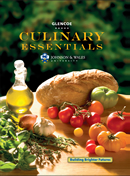
Culinary Essentials ©2010Chapter 21: Fish and ShellfishCheck Your Answers: After You ReadSection 21.1Review Key Concepts1. Flat fish have a backbone that runs horizontally through the center of the fish. They have both eyes on the top of their head. Flat fish have dark skin on their upper side to hide from predators.2. Fillets are the sides of a fish. Round fish produce one fillet from each side, while flat fish produce two fillets from the top and two from the bottom. Steaks are cross-section cuts of dressed fish. Practice Culinary Academics3. English Language Arts Fish is high in omega-3 fatty acids, which are good for the health of your heart. However, fish also absorb things from the water around them, and some fish have been shown to contain heavy metals and pollutants. Brochures should be clear and understandable and include both positive and negative aspects about including fish in one's diet.4. Social Studies Students' research should address the endangerment of fish species and the impact on ocean ecology caused by commercial fishing, as well as the controversies surrounding fish farming, such as the fish feed used, potential parasites, and environmental impact. 5. Mathematics The median is 6 ounces, while the mode is 6 ounces. Arranged in order, the lengths are 4, 4, 5, 5, 5, 6, 6, 6, 6, 6, 7, 7, 7, 8, and 8. The middle number (the mode) in this series is 6. Six also appears the most times (5) out of all the numbers, which makes it the median. Section 21.2Review Key Concepts1. Grade A is shellfish of the highest quality with no physical defects and a good odor and flavor. Grade B is shellfish of a good quality, but not the highest. Grade C is shellfish of fairly good quality.2. Univalves have a single shell. Bivalves have two shells that are hinged together. Cephalopods have a thin internal shell. 3. Crustaceans have a hard outer shell and jointed skeletons. 4. Methods of cooking squid include simmering the squid in a seasoned sauce or liquid or quickly frying the squid. Practice Culinary Academics5. Mathematics The fifth crab should weigh 15 ½ pounds. If x represents the weight of the fifth crab, then (12 + 14 + 16.5 + 17 + x) ÷ 5 = 15, or 59.5 + x = 15 × 5. This equation further reduces to 59.5 + x = 75, or x = 15.5.Section 21.3Review Key Concepts1. For sautéing, use just enough fat to cover the bottom of the pan. Pan-frying requires more fat. Use flour or breading to form a crust to prevent sticking. Brown the presentation side first, turn once, and then cook quickly over high heat until done.Practice Culinary Academics2. Science Students may observe that the shrimp marinated for a short time is more tender than the other groups of shrimp. An acid marinade tenderizes the shrimp by denaturing the proteins in it. It is actually a very mild form of cooking. However, marinating too much can overcook the shrimp and it can become tough again. It is important to find a balance.3. English Language Arts Groups should choose one method of cooking fish or shellfish and take the guidelines given in this section and transfer them to a poster in a manner that is easily readable and visually appealing. 4. Social Studies Commercial fishermen today usually use surrounding nets, seine nets, trawls, dredges, hooks and lines, lift nets, gillnets, entangling nets and traps. They also often process the fish and shellfish right on the boat. Students may talk about any of these pieces of equipment and how they compare to traditional fishing gear. 5. Mathematics The restaurant can get 60 sheets of parchment paper from the roll. 40 yards is the equivalent of 40 × 3 = 120 feet, and 120 × 12 = 1,440 inches. 1,440 inches ÷ 24 inches = 60. |  |















